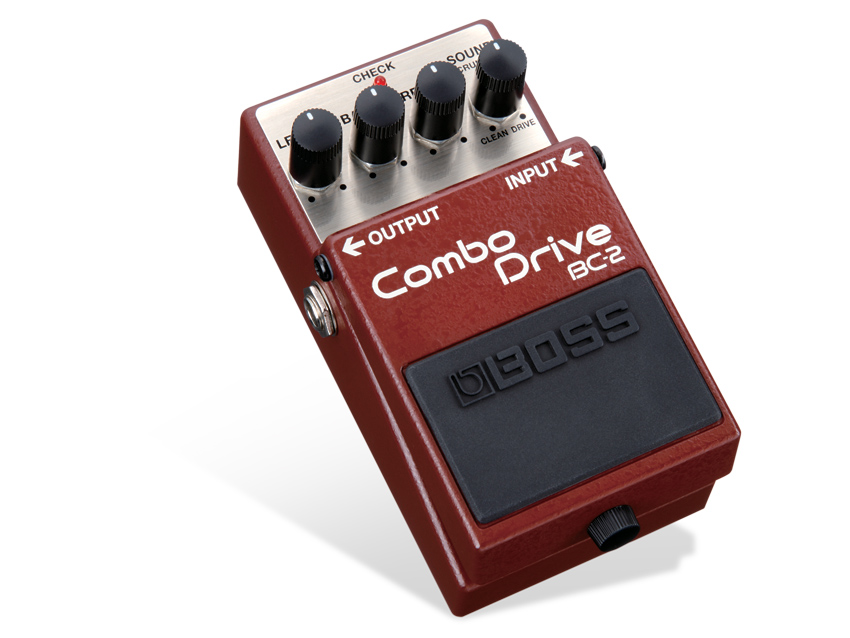MusicRadar Verdict
For some better than skin-deep retro action, this is well worth a gander.
Pros
- +
Surprisingly strong facsimile of the Vox AC30…
Cons
- -
…though you might not fool the purists.
MusicRadar's got your back
Just as blindfolded carnivores can chow down on a couple of Linda McCartney vegetarian sausages, agree that they taste like meat yet still know deep down that something's up, we guitarists can tell the difference between a classic amplifier and a modelling pedal.
But, folks, it's getting tougher. We're not privy to all the goings on behind closed doors at BOSS's R&D department, but we'd like to think that the boffins there are up to some sort of Richard Attenborough-style Jurassic Park weird science. You know, extracting amplifier DNA from amber fossilized in the '60s, cloning capacitors in a hermetically sealed lab and so on.
"The BC-2 pulls off a lovely pastiche of a classic combo."
Whatever its mad, voodoo working practices, BOSS is getting results. The BC-2 Combo Drive is the company's latest attempt to house all the tone from a classic amplifier in one compact unit.
Since rolling out its COSM modelling technology and putting it in multi-effects units such as the GT series, BOSS has been perfecting the tone-clone shtick, turning out the officially endorsed Fender line of modelling stompboxes in 2007. The BC-2, although less overtly marketed, is built in the same spirit, drawing its tonal character from a classic amplifier that became the sound of the '60s British Invasion, the Vox AC30.
It's easy to use, too. With just four knobs - Level, Bass, Treble and Sound - there's no need to reach for the manual. For best results, set the EQ flat on your amplifier (generally, all knobs set to 12 o'clock), use the pedal's Bass and Treble dials instead, and reach for the Sound - that's where the action is.
Sounds
The Sound knob has three voices: Clean, Crunch and Drive, with plenty of room in each for some experimentation. Turned fully counterclockwise in Clean, the BC-2 is nice and glassy, great for cats with a comprehensive chord vocabulary and a 12-string electric to hand.
Rolled clockwise, you start to get a bit more attitude, with some lovely break up that'll have blues players retiring to their porch for the evening, and the indie set applying all manner of jangle to their parts. The Drive settings are a lovely surprise, they're great fun with plenty of gain, and prove just the ticket for Brian May fans when partnered with a phaser.
The gain is warm and intuitive; that's a sign that the modelling technology is making the pedal think like an amplifier. And if it thinks like one, it's got a better chance of sounding like one.
The BC-2 isn't a direct portal to the past, though. It won't take you back to when the cathode ray television was still in style.
Even if you use it daily, free love will still be hard to come by and the price of a pint is never going to fall. But remember, it wasn't all fun and games; just try getting a wi-fi signal in 1963.
While there's still no substitute for the real thing - The Edge won't be retiring his AC30 just yet - the BC-2 does a lovely pastiche of a classic combo (you might say it sounds like a Vox in the way that a green Fruit Pastille tastes of lime). It might well be a tonal throwback, but this is a pedal very much of its time, and that time is now.
Jonathan Horsley has been writing about guitars and guitar culture since 2005, playing them since 1990, and regularly contributes to MusicRadar, Total Guitar and Guitar World. He uses Jazz III nylon picks, 10s during the week, 9s at the weekend, and shamefully still struggles with rhythm figure one of Van Halen’s Panama.
“We were arguing a lot and we were miserable”: How Green Day exceeded expectations with their most ambitious song
"There’s plenty for us guitarists to learn – and ‘less is more’ is the overriding lesson": how to play like George Harrison on The Beatles' Abbey Road
“They didn’t like Prince’s bikini underwear”: Prince’s support sets for the The Rolling Stones in 1981 are remembered as disastrous, but guitarist Dez Dickerson says that the the crowd reaction wasn’t as bad as people think











